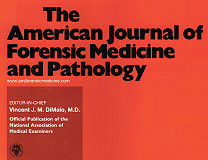

 |
 |
Deaths Due to an Uncontrolled Crowd |

CITATION:
Gill JR, Landi K: Traumatic asphyxial deaths due to an uncontrolled crowd.
Am J Forensic Med Pathol December, 2004;25: 358-361.
I've posted this Am J Forensic Med Pathol article in PDF file format.
If you don't have an Adobe Acrobat PDF file program, you can download a FREE version HERE.

CHAS REVIEW:
"The cause of death of all 9 decedents was asphyxia by
chest compression."
 I am extremely concerned that so many medical examiners and forensic pathologists continue to entirely disregard the importance of abdominal excursion to breathing. All of the mechanisms discussed in this report (various incidents of force applied to the torso from "front to back or vice versa") ALSO cause compression of the abdomen. The authors mentioned the fact that, when force is applied to someone's torso only from "side to side, chest expansion is not compromised." Similarly, application of force to the torso only from "side to side" doesn't compromise abdominal excursion, either.
I am extremely concerned that so many medical examiners and forensic pathologists continue to entirely disregard the importance of abdominal excursion to breathing. All of the mechanisms discussed in this report (various incidents of force applied to the torso from "front to back or vice versa") ALSO cause compression of the abdomen. The authors mentioned the fact that, when force is applied to someone's torso only from "side to side, chest expansion is not compromised." Similarly, application of force to the torso only from "side to side" doesn't compromise abdominal excursion, either.
 If "chest compression" was the only mechanism significant enough to cause the asphyxia of these victims, it is entirely reasonable to anticipate that at least ONE person might have suffered at least ONE fractured rib. (After all, even when appropriately performed, CPR chest compressions have caused fractured ribs or flailed sternums.) Yet, none of the victims discussed in this report demonstrated ANY bone fractures post mortem – not even a single "cracked" rib.
If "chest compression" was the only mechanism significant enough to cause the asphyxia of these victims, it is entirely reasonable to anticipate that at least ONE person might have suffered at least ONE fractured rib. (After all, even when appropriately performed, CPR chest compressions have caused fractured ribs or flailed sternums.) Yet, none of the victims discussed in this report demonstrated ANY bone fractures post mortem – not even a single "cracked" rib.
 Furthermore, the ONLY victim who had an "internal injury," had a liver laceration. No evidence of penetrating or obvious "blunt" injury was demonstrated by any victim. So, how did that victim's liver laceration occur? Was it perhaps caused by the generalized (equally dispersed) force of abdominal compression suffered by the victim? And, even though it was described as a "superficial" liver laceration, it was still a liver laceration. So, why did the likely-struggling victim loose merely 200 ml of blood into the peritoneum prior to death? Did generalized (equally dispersed) abdominal compression also tamponade the laceration, thus diminishing the blood loss that occurred prior to cardiopulmonary arrest?
Furthermore, the ONLY victim who had an "internal injury," had a liver laceration. No evidence of penetrating or obvious "blunt" injury was demonstrated by any victim. So, how did that victim's liver laceration occur? Was it perhaps caused by the generalized (equally dispersed) force of abdominal compression suffered by the victim? And, even though it was described as a "superficial" liver laceration, it was still a liver laceration. So, why did the likely-struggling victim loose merely 200 ml of blood into the peritoneum prior to death? Did generalized (equally dispersed) abdominal compression also tamponade the laceration, thus diminishing the blood loss that occurred prior to cardiopulmonary arrest?
BOTTOM LINE: Many medical examiners and forensic pathologists apparently need to review the education they originally received (way back when) regarding the basic – most vital – mechanics of breathing. A human being CAN adequately breathe without being able to expand her/his chest ... but, ONLY as long as she/he can expand her/his abdomen, allowing for effective diaphragm excursion. Considering the consistent lack of rib trauma demonstrated in victims of crowd-related traumatic asphyxia ("riot crush"), it is far more likely that the cause of death in these cases was abdominal compression – not "chest compression."
YOURS, CHAS


 Email Charly at: c-d-miller@neb.rr.com
Email Charly at: c-d-miller@neb.rr.com